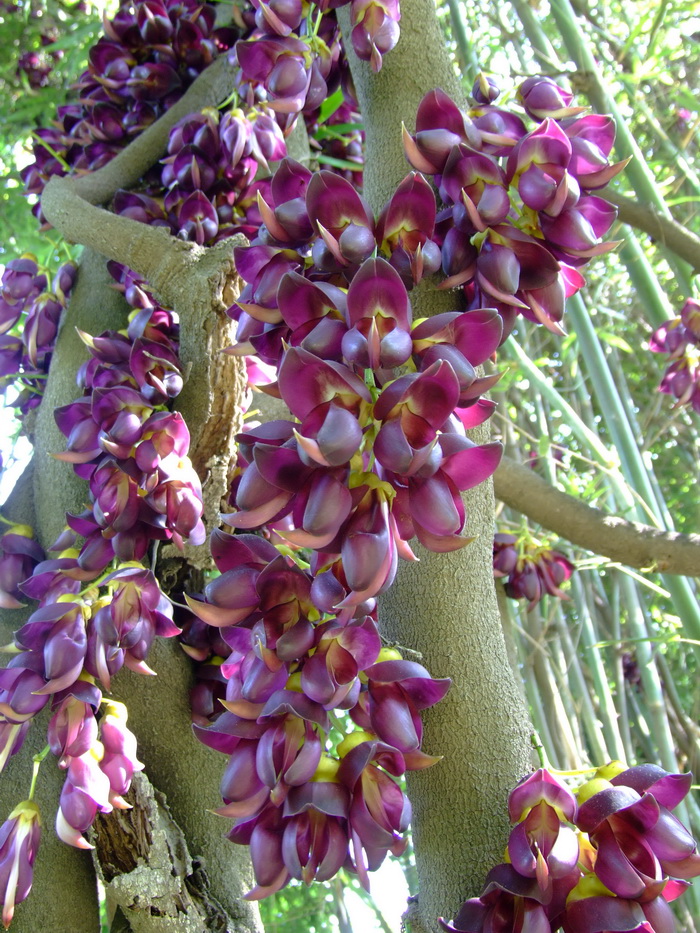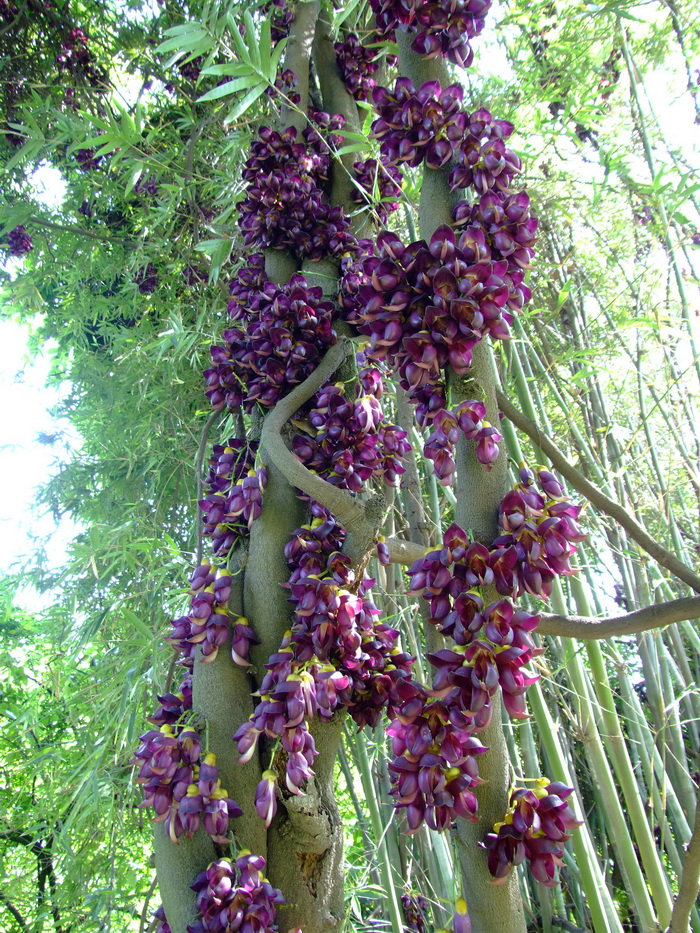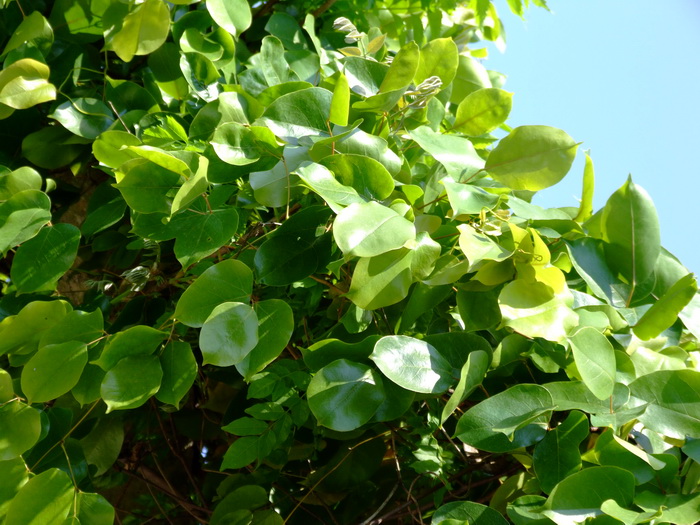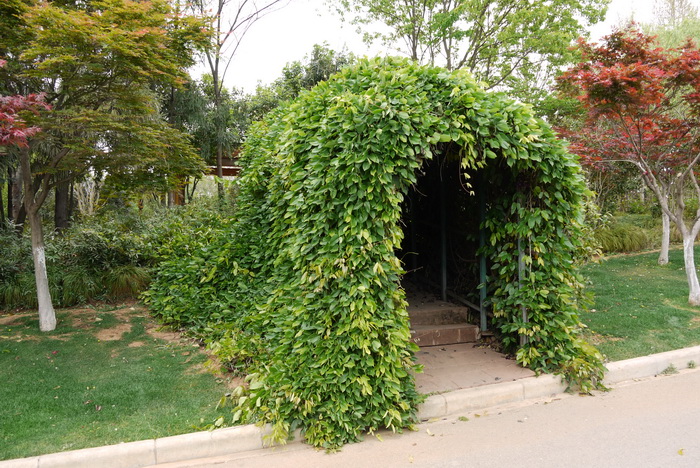常春油麻藤Mucuna sempervirens
中文名(Chinese Name):常春油麻藤
学名(Scientific Name):Mucuna sempervirens Hemsl.
英文名(English Common Name):
别名(Chinese Common Name):绵麻藤
异名(Synonym):Mucuna mairei H. Lév. Mucuna japonica Nakai Stizolobium sempervirens (Hemsl.) Kuntze Mucuna japoica Nakai Mucuna coriocarpa Hand.-Mazz.
科属(Family & Genus):蝶形花科,Fabaceae黧豆属
形态特征(Description):常绿木质藤本,长可达25米。老茎直径超过30厘米,树皮有皱纹,幼茎有纵棱和皮孔。羽状复叶具3小叶,叶长21-39厘米;托叶脱落;叶柄长7-16.5厘米;小叶纸质或革质,顶生小叶椭圆形,长圆形或卵状椭圆形,长8-15厘米,宽3.5-6厘米,先端渐尖头可达15厘米,基部稍楔形,侧生小叶极偏斜,长7-14厘米,无毛;侧脉4-5对,在两面明显,下面凸起;小叶柄长4-8毫米,膨大。总状花序生于老茎上,长10-36厘米,每节上有3花,无香气或有臭味;苞片和小苞片不久脱落,苞片狭倒卵形,长宽各15毫米;花梗长1-2.5厘米,具短硬毛;小苞片卵形或倒卵形;花萼密被暗褐色伏贴短毛,外面被稀疏的金黄色或红褐色脱落的长硬毛,萼筒宽杯形,长8-12毫米,宽18-25毫米;花冠深紫色,干后黑色,长约6.5厘米,旗瓣长3.2-4厘米,圆形,先端凹达4毫米,基部耳长1-2毫米,翼瓣长4.8-6厘米,宽1.8-2厘米,龙骨瓣长6-7厘米,基部瓣柄长约7毫米,耳长约4毫米;雄蕊管长约4厘米,花柱下部和子房被毛。果木质,带形,长30-60厘米,宽3-3.5厘米,厚1-1.3厘米,种子间缢缩,近念珠状,边缘多数加厚,凸起为一圆形脊,中央无沟槽,无翅,具伏贴红褐色短毛和长的脱落红褐色刚毛,种子4-12颗,内部隔膜木质;带红色,褐色或黑色,扁长圆形,长约2.2-3厘米,宽2-2.2厘米,厚1厘米,种脐黑色,包围着种子的3/4。花期4-5月,果期8-10月。
分布(Distribution):产四川、贵州、云南、陕西、湖北、浙江、江西、湖南、福建、广东、广西。生于海拔300-3000米的亚热带森林,灌木丛,溪谷,河边。日本也有。
用途(Use):茎藤药用,有活血去瘀,舒筋活络之效;茎皮可织草袋及制纸;块根可提取淀粉;种子可榨油。
引自植物志英文版:FOC Vol. 10 Page 208, 210, 212
Mucuna sempervirens Hemsley, J. Linn. Soc., Bot. 23: 190. 1887.
常春油麻藤 chang chun you ma teng | Fabaceae | Mucuna
?Mucuna coriocarpa Handel-Mazzetti; M. japonica Nakai; M. mairei H. Léveillé.
Woody vines, up to 25 m. Old stems over 30 cm in diam., young stems glabrous or rarely with sparse stiff pale hairs. Leaves 20-40 cm; petiole 7-16.5 cm, glabrous or with sparse hairs like stem; stipels not persistent; leaflets papery or thicker textured, glabrous or with fine pale stiff hairs, lateral veins 4 or 5 pairs, gently curved; terminal leaflet elliptic or elliptic-ovate, 8-15(-19) × 3.5-9 cm, base slightly cuneate, apex acuminate to 15 cm; lateral leaflets 7-14 cm, width ratio of abaxial to adaxial halves 1.25-1.5:1, abaxial half with base often truncate or slightly cordate. Inflorescences usually on old stems, 10-36 cm, with 5-10 nodes throughout length; bracts caducous, narrowly obovate, ca. 1.5 mm long and wide; bracteoles ovate or obovate, caducous; pedicels 1-2.5 cm, with stiff dark short adpressed hairs. Calyx with dense adpressed hairs on both sides and sparse caducous bristles outside; tube 8-12 × 18-25 mm; lateral lobes 5-8 mm, equaling lowest lobe or almost so, broadly triangular, upper lip often equaling lateral lobes. Corolla deep purple, black after drying; standard 3.2-4 cm; wings rather wide, 4.8-6 × 1.8-2 cm; keel 6-7 cm. Legume linear, straight or slightly curved, 30-60 × 3-3.5 cm, 1-1.3 cm thick, woody, with dense short fine red-brown hairs and sparse caducous reddish brown bristles, surface with conspicuous irregularly reticulate patterning, margins and surface constricted between seeds, base often with abrupt narrow neck, margin thickened into a well-defined smooth rounded ridge running along suture without a wing or median groove, apex acute. Seeds 4-12, shiny red, brown, or black, oblong or discoid, 2.2-3.2 × 2-2.8 cm, ca. 1 cm thick; septum woody; hilum black, length ca. 3/4 of seed circumference. Fl. Apr-May, fr. Aug-Oct. 2n = 22, 44.
Forests, thickets, riversides; 300-3000 m. Fujian, Guangdong, Guangxi, Guizhou, Hubei, Hunan, Jiangxi, Shaanxi, Sichuan, Yunnan, Zhejiang [Bhutan, NE India (W Bengal, Manipur, Sikkim), Japan, Myanmar].
Mucuna sempervirens is easily distinguished in flower from most other species with large purple flowers by its leaves without persistent stipels. It is often confused in fruit with M. macrocarpa, which differs by its legume without a distinct rounded margin and with a coarser surface patterning, its bicolored flowers with pubescent apex, and its leaves often with reddish hairs. Mucuna calophylla also lacks persistent stipels but has much smaller flowers and fruit and has leaves usually densely silky hairy abaxially.
This species is used medicinally and for paper-making, starch, and oil.



 (责任编辑:徐晔春)
(责任编辑:徐晔春)
学名(Scientific Name):Mucuna sempervirens Hemsl.
英文名(English Common Name):
别名(Chinese Common Name):绵麻藤
异名(Synonym):Mucuna mairei H. Lév. Mucuna japonica Nakai Stizolobium sempervirens (Hemsl.) Kuntze Mucuna japoica Nakai Mucuna coriocarpa Hand.-Mazz.
科属(Family & Genus):蝶形花科,Fabaceae黧豆属
形态特征(Description):常绿木质藤本,长可达25米。老茎直径超过30厘米,树皮有皱纹,幼茎有纵棱和皮孔。羽状复叶具3小叶,叶长21-39厘米;托叶脱落;叶柄长7-16.5厘米;小叶纸质或革质,顶生小叶椭圆形,长圆形或卵状椭圆形,长8-15厘米,宽3.5-6厘米,先端渐尖头可达15厘米,基部稍楔形,侧生小叶极偏斜,长7-14厘米,无毛;侧脉4-5对,在两面明显,下面凸起;小叶柄长4-8毫米,膨大。总状花序生于老茎上,长10-36厘米,每节上有3花,无香气或有臭味;苞片和小苞片不久脱落,苞片狭倒卵形,长宽各15毫米;花梗长1-2.5厘米,具短硬毛;小苞片卵形或倒卵形;花萼密被暗褐色伏贴短毛,外面被稀疏的金黄色或红褐色脱落的长硬毛,萼筒宽杯形,长8-12毫米,宽18-25毫米;花冠深紫色,干后黑色,长约6.5厘米,旗瓣长3.2-4厘米,圆形,先端凹达4毫米,基部耳长1-2毫米,翼瓣长4.8-6厘米,宽1.8-2厘米,龙骨瓣长6-7厘米,基部瓣柄长约7毫米,耳长约4毫米;雄蕊管长约4厘米,花柱下部和子房被毛。果木质,带形,长30-60厘米,宽3-3.5厘米,厚1-1.3厘米,种子间缢缩,近念珠状,边缘多数加厚,凸起为一圆形脊,中央无沟槽,无翅,具伏贴红褐色短毛和长的脱落红褐色刚毛,种子4-12颗,内部隔膜木质;带红色,褐色或黑色,扁长圆形,长约2.2-3厘米,宽2-2.2厘米,厚1厘米,种脐黑色,包围着种子的3/4。花期4-5月,果期8-10月。
分布(Distribution):产四川、贵州、云南、陕西、湖北、浙江、江西、湖南、福建、广东、广西。生于海拔300-3000米的亚热带森林,灌木丛,溪谷,河边。日本也有。
用途(Use):茎藤药用,有活血去瘀,舒筋活络之效;茎皮可织草袋及制纸;块根可提取淀粉;种子可榨油。
引自植物志英文版:FOC Vol. 10 Page 208, 210, 212
Mucuna sempervirens Hemsley, J. Linn. Soc., Bot. 23: 190. 1887.
常春油麻藤 chang chun you ma teng | Fabaceae | Mucuna
?Mucuna coriocarpa Handel-Mazzetti; M. japonica Nakai; M. mairei H. Léveillé.
Woody vines, up to 25 m. Old stems over 30 cm in diam., young stems glabrous or rarely with sparse stiff pale hairs. Leaves 20-40 cm; petiole 7-16.5 cm, glabrous or with sparse hairs like stem; stipels not persistent; leaflets papery or thicker textured, glabrous or with fine pale stiff hairs, lateral veins 4 or 5 pairs, gently curved; terminal leaflet elliptic or elliptic-ovate, 8-15(-19) × 3.5-9 cm, base slightly cuneate, apex acuminate to 15 cm; lateral leaflets 7-14 cm, width ratio of abaxial to adaxial halves 1.25-1.5:1, abaxial half with base often truncate or slightly cordate. Inflorescences usually on old stems, 10-36 cm, with 5-10 nodes throughout length; bracts caducous, narrowly obovate, ca. 1.5 mm long and wide; bracteoles ovate or obovate, caducous; pedicels 1-2.5 cm, with stiff dark short adpressed hairs. Calyx with dense adpressed hairs on both sides and sparse caducous bristles outside; tube 8-12 × 18-25 mm; lateral lobes 5-8 mm, equaling lowest lobe or almost so, broadly triangular, upper lip often equaling lateral lobes. Corolla deep purple, black after drying; standard 3.2-4 cm; wings rather wide, 4.8-6 × 1.8-2 cm; keel 6-7 cm. Legume linear, straight or slightly curved, 30-60 × 3-3.5 cm, 1-1.3 cm thick, woody, with dense short fine red-brown hairs and sparse caducous reddish brown bristles, surface with conspicuous irregularly reticulate patterning, margins and surface constricted between seeds, base often with abrupt narrow neck, margin thickened into a well-defined smooth rounded ridge running along suture without a wing or median groove, apex acute. Seeds 4-12, shiny red, brown, or black, oblong or discoid, 2.2-3.2 × 2-2.8 cm, ca. 1 cm thick; septum woody; hilum black, length ca. 3/4 of seed circumference. Fl. Apr-May, fr. Aug-Oct. 2n = 22, 44.
Forests, thickets, riversides; 300-3000 m. Fujian, Guangdong, Guangxi, Guizhou, Hubei, Hunan, Jiangxi, Shaanxi, Sichuan, Yunnan, Zhejiang [Bhutan, NE India (W Bengal, Manipur, Sikkim), Japan, Myanmar].
Mucuna sempervirens is easily distinguished in flower from most other species with large purple flowers by its leaves without persistent stipels. It is often confused in fruit with M. macrocarpa, which differs by its legume without a distinct rounded margin and with a coarser surface patterning, its bicolored flowers with pubescent apex, and its leaves often with reddish hairs. Mucuna calophylla also lacks persistent stipels but has much smaller flowers and fruit and has leaves usually densely silky hairy abaxially.
This species is used medicinally and for paper-making, starch, and oil.
踩一下[0]

顶一下[9]